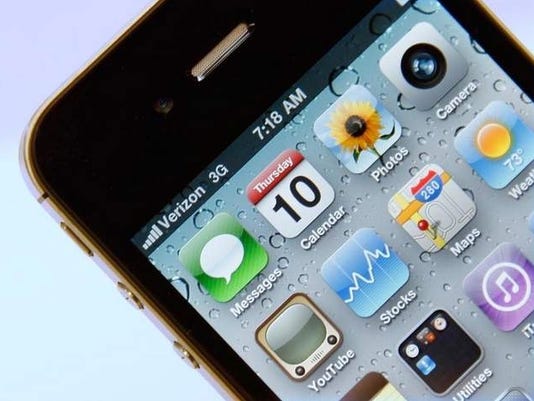
A photo of an iPhone from Apple on Verizon Wireless service. (Photo: AP Photo/Amy Sancetta)
For better or worse, Twitter users have made the social media site into a major source of information. We've come to rely on the Twitterati to share and divulge immediate details about events both trivial (the reunion of Destiny's Child at the Super Bowl) and very serious (riots and military coups). Now, Twitter is helping us see the worldwide distribution of smartphones like never before.
Using geolocation data from over 280 million mobile tweets, social media data company Gnip and data visualization company MapBox collaborated with ex-Google data maestro Eric Fischer to compile an interactive Twitter-use heat map. Using tweets collected since September 2011, the map illustrates the global usage and distribution of Apple iOS, Android, and BlackBerry smartphones. The interactive map, which you can view here, and also below, codes iPhone tweets as red, Android tweets as green, and BlackBerry tweets as purple.
In broad terms, the map shows the U.S. heavily shaded in red, with a significant portion of red dots falling in the Eastern half of the country (the Midwest is mostly black, with splotches of red and dots of green). The thickest concentrations of iPhone tweets come from metro areas like New York City, Chicago, Dallas, and Los Angeles. When you zoom in on these metropolises, however, pockets of green (for Google use) reveal themselves. Manhattan is vibrantly red, but across the Hudson River, Google actually dominates in Jersey City. Across the East River, Queens and Brooklyn (particularly the less affluent areas) are mostly green as well.
Perhaps most interesting and visually surprising thing about the map is the solidly purple spots in Midtown and the Financial District in Manhattan, where business people are still loyal to their BlackBerrys. Less than 500 miles to the northwest, there's another bastion of purple in Toronto, the closest big city to Waterloo, Ontario, where BlackBerry is headquartered.
In Mexico, spots of purple become more common. In fact, throughout Central and South America, BlackBerry is still the dominant smartphone, with strongholds of Android and iOS only really appearing in Brazil around city centers. BlackBerry also dominates Southeast Asia and the few spots in Africa that have any mobile Twitter usage, as well as the Iberian Peninsula.
China is dark, of course, because Twitter is blocked by the Chinese government, but South Korea is mostly green while Japan is predominantly red.
However, it is important to note that the map looks more cut and dry from far away; when you zoom in on a major block of red, green, or purple, streaks are clearly visible. More importantly, these maps only track Twitter use on mobile devices and don't account for biases. (Are iPhone users more likely to tweet than Android users?)
To give this information more context, we can look to the most recent Internet Wars Report from the Web traffic analysis company StatCounter. The report measures several worldwide tech metrics from July 2012 to July 2013, and illustrates how competitive the battle for mobile dominance is. Only last month did Android, with a global market share of 25.47%, overtake Apple, with 25.09%. In the same month, BlackBerry scored a 3.62% market share. However, as the Twitter map also revealed, iOS retains a strong lead in the US and the UK. Also important to note from the report is that Nokia holds a strong third place in global mobile usage with 21.96% as of last month; the Twitter heat map doesn't include Nokia phones.
Rumors have circulated for many months that Apple is developing a cheaper iPhone to appeal to lower income consumers. Looking at both the Twitter heat map and the StatCounter report, it seems like a cheaper iPhone would certainly broaden the iPhone's global reach.
This story was originally published on Minyanville.
MORE FROM MINYANVILLE This feature is needed to make Apple TV exciting With no flying cars or hoverboards, the Hyperloop will have to do Elon Musk's latest idea: The Hyperloop
No comments:
Post a Comment